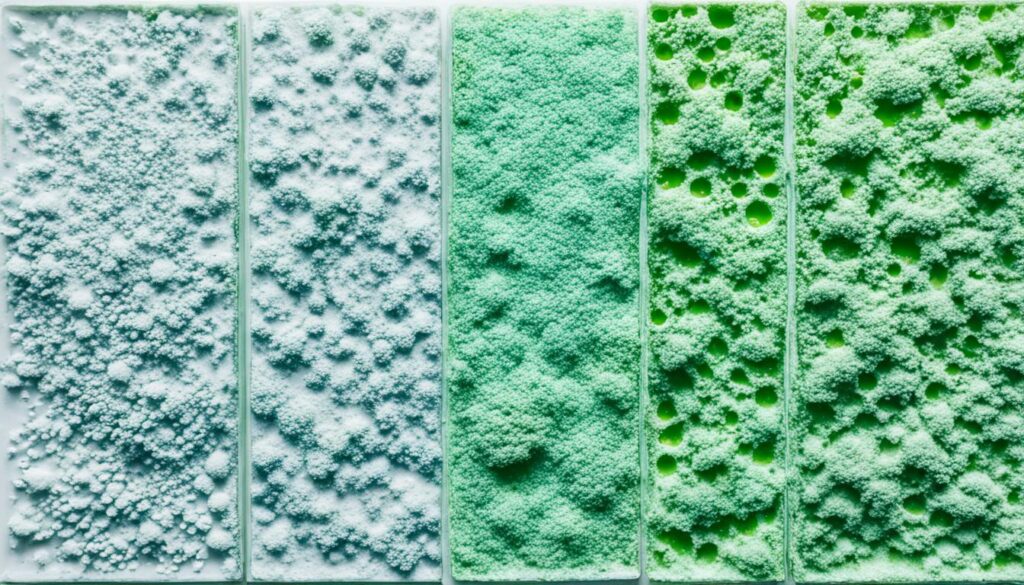
Understanding What’s Mold in Miami – A Guide
Welcome to our comprehensive guide on mold in Miami. In this informative article, we will explore the presence of mold, how to identify it, the health risks associated with mold exposure, and provide tips for removing mold to create a safer home environment. Mold presence in Miami is a common issue due to the warm and humid climate, making it crucial for homeowners to be knowledgeable about mold and its potential consequences.
Key Takeaways:
- Mold presence is a common issue in Miami due to the warm and humid climate.
- Identifying mold is essential for addressing the problem effectively.
- Exposure to mold can lead to various health risks, including respiratory issues.
- Proper mold removal techniques are crucial for creating a safer home environment.
- Seeking professional mold assessment and remediation services can ensure thorough mold removal.
Mold Identification and Risks in Miami
In this section, we will delve into the details of mold identification in Miami. Understanding the signs and symptoms of mold growth, as well as the specific risks associated with mold exposure, is crucial for homeowners in this region. By recognizing the presence of mold and its potential health hazards, individuals can take proactive measures to prevent and mitigate mold issues.
- Common Signs of Mold Growth: Mold can manifest in various ways, and homeowners should be vigilant for any of the following signs:
- Visible mold growth on surfaces such as walls, ceilings, or floors.
- A strong, musty odor in certain areas of the house.
- Water stains or discoloration on walls or ceilings, indicating moisture issues.
- Allergic reactions, such as coughing, sneezing, or watery eyes, that worsen when indoors.
- Types of Mold Found in Miami: Miami’s warm and humid climate creates conditions favorable for mold growth. Some common types of mold found in this region include:
- Stachybotrys chartarum (black mold)
- Aspergillus
- Cladosporium
- Penicillium
- Alternaria
- Risks Associated with Mold Exposure in Miami: Mold exposure can pose various health risks, especially for individuals with respiratory issues or weakened immune systems. Some potential health effects of mold exposure include:
- Allergic reactions, such as nasal congestion, skin rashes, or irritated eyes.
- Respiratory problems, including coughing, wheezing, or difficulty breathing.
- Infections, particularly in individuals with compromised immune systems.
- Exacerbation of asthma symptoms.
“Being able to identify mold and understand the associated risks is the first step in addressing the problem. By taking appropriate measures, homeowners can protect their health and create a safer living environment.”
Image: Mold Growth – Miami

| Mold Type | Description | Health Risks |
|---|---|---|
| Stachybotrys chartarum (Black Mold) | A greenish-black mold commonly found in areas with excessive moisture. It releases toxic compounds known as mycotoxins. | Potential respiratory issues, skin irritation, and allergic reactions. |
| Aspergillus | A common mold found indoors and outdoors. It can vary in color and has a velvety or powdery appearance. | Allergic reactions, respiratory problems, and infections in individuals with weakened immune systems. |
| Cladosporium | A black or green mold that can thrive on damp surfaces, including carpets, wallpaper, and fabrics. | Allergic reactions, asthma attacks, and skin infections. |
| Penicillium | A bluish-green mold commonly found in water-damaged buildings or materials. It can produce musty odors. | Respiratory issues, sinus infections, and allergic reactions. |
| Alternaria | A black or dark green mold commonly found in damp areas, such as showers or under sinks. | Allergic reactions, asthma attacks, and respiratory infections. |
Effective Mold Removal Tips for a Safer Home Environment
In order to create a safer home environment, it is essential to effectively remove mold and prevent its recurrence. Here are some valuable mold removal tips:
1. Identify and address the source of moisture: To prevent mold growth, it is crucial to identify and fix any sources of moisture in your home. Leaky pipes, roof leaks, or damp basements can create the perfect conditions for mold to thrive. By addressing these issues promptly, you can minimize the chances of mold growth.
2. Proper ventilation and airflow: Good ventilation is essential for maintaining a mold-free environment. Ensure that your home has adequate airflow, especially in areas prone to moisture, such as bathrooms and kitchens. Use exhaust fans and open windows to promote air circulation and reduce humidity levels.
3. Clean and dry affected areas: If you discover mold in your home, it is important to clean and dry the affected areas thoroughly. Use a mixture of water and detergent to scrub the mold off surfaces and then dry the area completely. This will help prevent further mold growth.
While these tips can assist in small-scale mold removal, it is advisable to seek professional assistance for extensive mold infestations. Fix Mold Miami is a reputable service provider that specializes in mold assessment, prevention, and remediation. By utilizing their expertise, you can ensure a thorough and effective mold removal process.
To schedule an appointment with Fix Mold Miami or to learn more about their services, you can contact them at (305) 465-6653.




